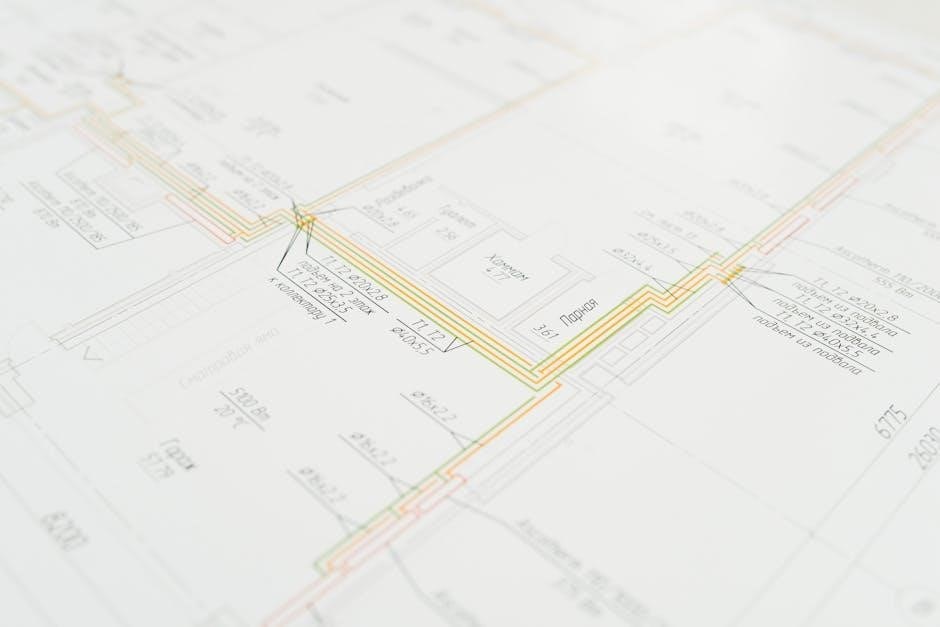The EDI 810 Specification defines the ANSI X12 standard for electronic invoicing, enabling businesses to exchange digital invoices, streamlining billing processes, and enhancing efficiency while reducing errors.
1.1 Definition and Purpose of EDI 810
The EDI 810 is an electronic data interchange document that serves as a digital invoice, enabling suppliers to request payment for goods or services provided. It follows the ANSI X12 standard, replacing traditional paper invoices to streamline billing processes. The EDI 810 typically follows an EDI 850 Purchase Order, ensuring efficient and accurate transactions between trading partners while reducing errors and enhancing operational efficiency.
1.2 Overview of ANSI X12 Standard
The ANSI X12 standard is a widely adopted framework for electronic data interchange, defining the structure and data content for transactions like the EDI 810 invoice. It ensures consistency and interoperability between trading partners, providing a common format for exchanging business documents. The standard includes specific segments, data elements, and transaction sets, enabling efficient and accurate electronic communication of invoicing and billing information across industries.

Structure of EDI 810 Invoice
The EDI 810 invoice follows a structured format with predefined segments and elements, ensuring organized data exchange. It includes key components like invoice details, payment terms, and product information, adhering to the ANSI X12 standard for seamless electronic transactions.
2.1 Segments and Elements Overview
The EDI 810 invoice is composed of multiple segments, each representing specific data components. Key segments include ISA, GS, GE, which define interchange, group, and transaction boundaries. Elements within these segments provide detailed information such as invoice numbers, dates, amounts, and product details. The structure ensures data consistency and compliance with the ANSI X12 standard, facilitating accurate and efficient processing between trading partners.
2.2 Key Segments: ISA, GS, and GE
The EDI 810 invoice begins with the ISA (Interchange Control Header) segment, defining the interchange boundaries. The GS (Functional Group Header) segment groups related transactions, while the GE (Functional Group Trailer) marks its end. These segments ensure proper structuring and identification of the invoice, enabling seamless data exchange between trading partners and maintaining compliance with ANSI X12 standards.

2.3 Mandatory Data Elements
The EDI 810 invoice requires specific mandatory data elements to ensure compliance and proper processing. These include the invoice number, date, total amount, and identifiers for both the buyer and seller. Additional elements like product codes, quantities, and pricing details are also essential, ensuring all necessary information is present for accurate billing and payment processing. These elements are critical for maintaining clarity and functionality in the transaction set.
Key Components of EDI 810
The EDI 810 includes essential components like invoice details, payment terms, product information, tax calculations, and freight charges, ensuring comprehensive and accurate billing for seamless transactions.
3.1 Invoice Details and Numbering
The EDI 810 specifies structured invoice details, including invoice numbers, dates, and reference numbers, ensuring uniqueness and traceability. It follows ANSI X12 standards, requiring precise formatting to avoid duplication and errors in payment processing. This section is crucial for maintaining accurate financial records and ensuring that each invoice is distinct and easily identifiable by both seller and buyer systems.

3.2 Payment Terms and Conditions
The EDI 810 specifies payment terms and conditions, including discount periods, due dates, and penalties, using standardized codes. It outlines acceptable payment methods and terms, ensuring clarity and compliance with agreed-upon financial agreements. This section is essential for automating payment processing and avoiding disputes, as it provides a clear understanding of payment expectations and deadlines for both buyers and sellers.
3.3 Product and Service Information
The EDI 810 details product and service specifics, including item descriptions, quantities, and pricing. It uses standardized codes to describe items, ensuring accurate identification and billing. This section supports seamless processing by providing clear product data, reducing errors in order fulfillment and invoicing. It’s crucial for maintaining precise records and facilitating efficient transactions between suppliers and buyers.
3.4 Tax and Freight Charges
The EDI 810 specifies tax and freight charges, ensuring clarity in billing. It includes tax amounts, identifiers, and freight details, using standardized codes for accurate processing. Freight charges are detailed with codes like SAC for services, while taxes are itemized by type and amount. This section ensures compliance with financial regulations and provides transparency for both suppliers and buyers, facilitating smooth payment processing and accounting.
Benefits of Using EDI 810
EDI 810 streamlines transactions, reduces manual processes, and enhances accuracy. It automates invoicing, accelerates payment cycles, and minimizes errors, improving overall business efficiency and cash flow management.
4.1 Automation and Efficiency
4.2 Reduced Errors and Faster Processing
EDI 810 minimizes manual data entry, reducing errors and speeding up transaction processing. Automated data exchange ensures accuracy, accelerates payment cycles, and enhances overall operational efficiency, fostering stronger supplier-buyer relationships.
EDI 810 eliminates manual data entry, significantly reducing errors and accelerating transaction processing. Automated data exchange ensures accuracy, while standardized formats streamline invoice validation. This results in faster payment cycles, improved cash flow, and enhanced operational efficiency for both suppliers and buyers, fostering seamless and reliable business transactions.
4.3 Improved Supplier-Buyer Relationships
EDI 810 fosters transparency and trust by providing clear, consistent invoice data, reducing disputes and delays. Automated processes ensure timely payments, strengthening collaboration and satisfaction between suppliers and buyers. This seamless communication enhances long-term partnerships, driving mutual growth and loyalty in business relationships.
Challenges in Implementing EDI 810
Implementing EDI 810 involves high initial costs, complex setup, and ensuring data format compliance with ANSI X12 standards, which can be resource-intensive for businesses.
5.1 Complexity of Setup and Integration
The EDI 810 setup requires precise mapping of data fields, compliance with ANSI X12 standards, and alignment with trading partners’ systems, often involving custom integration. This complexity demands significant technical expertise and time, as businesses must ensure seamless communication between their ERP systems and EDI platforms. Additionally, variations in trading partner requirements can complicate the setup process, making it resource-intensive and challenging for organizations to manage effectively.

5.2 High Initial Investment Costs
Implementing EDI 810 often requires significant upfront costs, including software licensing, hardware setup, and personnel training. Businesses must invest in EDI platforms, integrate systems with trading partners, and ensure compliance with ANSI X12 standards. Additional expenses include customizations, testing, and ongoing maintenance, making the initial investment substantial for organizations adopting this technology.
5.3 Data Format and Compliance Issues
EDI 810 requires strict adherence to ANSI X12 standards, ensuring data consistency and accuracy. Compliance complexities arise from specific segment and element requirements, such as proper formatting of invoice numbers and dates. Businesses must meticulously map data fields to avoid errors, ensuring seamless transactions. Non-compliance can lead to rejected invoices and trading partner disputes, underscoring the need for precise implementation and ongoing updates to maintain adherence to evolving standards.
Tools and Solutions for EDI 810
EDI 810 tools include software providers and cloud-based solutions, offering automation, data mapping, and compliance support to streamline invoice transactions and enhance integration capabilities for businesses.
6.1 Overview of EDI Software and Providers
EDI software and providers offer tailored solutions for managing EDI 810 transactions, enabling seamless data exchange and compliance with ANSI X12 standards. These tools provide robust features like data mapping, automated processing, and integration with ERP systems. Leading providers offer scalable solutions, from on-premise to cloud-based platforms, ensuring businesses can efficiently handle invoicing and billing processes. Orderful is an example of a platform that simplifies EDI onboarding and supports end-to-end transaction management.
6.2 Role of Cloud-Based EDI Solutions
Cloud-based EDI solutions provide scalable, flexible, and cost-effective tools for managing EDI 810 transactions. These platforms allow businesses to automate invoicing processes, reduce manual errors, and improve collaboration with trading partners. Cloud solutions, like Orderful, enable rapid onboarding, real-time data exchange, and seamless integration with existing systems, ensuring compliance with ANSI X12 standards and optimizing the entire order-to-cash cycle.
6.3 Example: Orderful EDI Platform
Orderful EDI Platform simplifies EDI 810 implementation, offering a cloud-based solution for seamless invoice exchanges. It enables rapid onboarding, automates workflows, and ensures compliance with ANSI X12 standards. By integrating with existing systems, Orderful reduces manual errors and accelerates payment cycles, making it an efficient tool for businesses to streamline their billing processes and enhance collaboration with trading partners.

Related EDI Transaction Sets
EDI 810 is part of a broader ecosystem of transaction sets, including EDI 850 (Purchase Order) and EDI 997 (Functional Acknowledgment), enabling seamless business communication and data exchange.
7.1 EDI 850: Purchase Order
The EDI 850 Purchase Order is a digital document sent by buyers to suppliers, detailing requested goods or services. It initiates the transaction cycle, followed by the EDI 810 invoice. Compliant with ANSI X12 standards, it includes purchase order numbers, product details, quantities, and delivery instructions, ensuring clarity and efficiency in procurement processes, and facilitating smooth business transactions, which is crucial for maintaining supplier-buyer relationships.
7.2 EDI 997: Functional Acknowledgment
The EDI 997 Functional Acknowledgment confirms receipt of an EDI transaction, such as an EDI 810 invoice, ensuring data integrity and compliance with ANSI X12 standards. It verifies successful transmission and validates the structure of the document, enabling seamless communication between trading partners by confirming the acceptance or rejection of the interchange, thus maintaining efficient and reliable business operations and reducing errors in data exchange.
7.3 EDI 810 vs. Other Invoice Formats
The EDI 810 stands out among other invoice formats due to its versatility and broad applicability across industries. Unlike the EDI 880, which is specific to grocery suppliers, the EDI 810 is widely used for both food and non-food-related transactions. It offers a standardized structure under ANSI X12, ensuring consistency and efficiency in billing processes, making it a preferred choice for businesses seeking streamlined electronic invoicing solutions.

Example of EDI 810 in Use
An EDI 810 transaction illustrates how businesses streamline billing processes. A raw example showcases invoice details, such as item descriptions and pricing, facilitating seamless communication between trading partners.
8.1 Raw EDI 810 Example
A raw EDI 810 example appears as a string of coded segments, such as ISA, GS, and GE, marking the interchange, functional group, and transaction set boundaries. It includes invoice-specific details like invoice numbers, dates, and item descriptions. For instance: ISA00 00 … GSIN… IT1125EA25.22… This format enables seamless data parsing by EDI systems, ensuring accurate and efficient processing of billing information for trading partners.
8.2 Interpretation of EDI 810 Data
EDI 810 data is interpreted by breaking down its structured segments into readable information. For example, invoice details like numbers and dates are extracted, while product information and pricing are decoded. Freight charges and tax details are also parsed, providing a clear, organized view of the invoice. This interpretation enables seamless processing and understanding by both systems and users, facilitating efficient payment and reconciliation processes;

Best Practices for EDI 810 Implementation
Implementing EDI 810 requires thorough planning, testing, and validation to ensure accuracy and compliance. Regular updates and training are essential for maintaining smooth and efficient operations.
9.1 Planning and Preparation
Effective EDI 810 implementation begins with clear goal definition and alignment with trading partners. Mapping data elements to ANSI X12 standards ensures compliance. Conduct thorough testing with sample data to identify gaps. Train staff on EDI processes and system integration. Regularly update workflows to adapt to evolving standards. A well-planned approach minimizes errors and ensures seamless integration, fostering efficient and accurate invoice exchanges.
9.2 Testing and Validation
Thoroughly test EDI 810 transactions using sample invoices to ensure data accuracy and compliance. Validate segments like ISA, GS, and GE for proper formatting. Verify mandatory elements such as invoice numbers and dates. Conduct end-to-end testing with trading partners to confirm seamless data exchange. Address errors promptly and refine processes to maintain consistency. Regular validation ensures reliable and efficient transaction processing, minimizing disruptions and enhancing overall system performance.
9.3 Ongoing Maintenance and Support
Regularly update and monitor your EDI system to ensure compliance with ANSI X12 standards. Provide ongoing technical support to resolve issues promptly. Maintain communication with trading partners to adapt to changes. Continuous monitoring and updates ensure smooth operation and prevent data discrepancies. Invest in reliable EDI software and support services to handle troubleshooting and optimize processes efficiently, ensuring long-term performance and accuracy in EDI 810 transactions.

Troubleshooting Common Issues
Identify and resolve data format errors, mismatched information, and system compatibility issues promptly. Regular updates and data validation ensure smooth EDI 810 transaction processing and minimize disruptions.
10.1 Resolving Data Format Errors
Resolving data format errors in EDI 810 involves verifying segment structure and element compliance with ANSI X12 standards. Validate delimiters, ensure proper field lengths, and check for invalid characters. Use EDI validation tools to identify discrepancies and cross-reference with the specification guide. Correcting these issues ensures seamless transaction processing and prevents rejection of invoices by trading partners. Regular testing and updates help maintain compliance and reduce future errors.
10.2 Handling Missing or Incorrect Data
Address missing or incorrect data in EDI 810 by identifying errors through validation tools and cross-referencing with the ANSI X12 specification. Collaborate with trading partners to clarify discrepancies and resubmit corrected invoices. Ensure all mandatory fields are populated and data alignment matches predefined formats. Implement proactive data checks and training to minimize future issues and maintain smooth transaction processing.
10.3 Managing Version Updates and Compliance
Stay updated with ANSI X12 version changes to ensure EDI 810 compliance. Regularly review updates and adapt systems accordingly. Conduct training sessions for teams to understand new requirements. Implement automated validation tools to verify compliance with the latest standards. Engage with EDI providers for support and resources, ensuring seamless transitions during version upgrades. This proactive approach maintains compliance and avoids processing disruptions.
The EDI 810 specification is a cornerstone of modern business transactions, enabling efficient, accurate, and compliant invoicing. Its adoption ensures streamlined operations and supports long-term growth.
11.1 Summary of EDI 810 Importance
The EDI 810 Invoice is a critical component of electronic data interchange, enabling efficient and accurate billing processes. It replaces paper-based invoices, reducing errors and speeding up payment cycles. By standardizing invoice formats, it ensures compliance with industry norms and enhances supplier-buyer relationships. Its adoption streamlines financial operations, improves cash flow, and supports scalability in business transactions, making it indispensable for modern commerce.
11.2 Future of EDI in Business Transactions
The future of EDI in business transactions is promising, with advancements in technology driving efficiency. Cloud-based EDI solutions and AI integration will enhance automation and scalability. Businesses can expect faster processing, improved accuracy, and real-time data exchange. As industries evolve, EDI will remain a cornerstone of digital commerce, fostering seamless collaboration and innovation in global supply chains and financial operations.

Additional Resources
Explore ANSI X12 guides, online forums, and professional training for deeper insights into EDI 810. Visit Orderful and FisherWebServices for comprehensive resources and expert support.
12.1 Recommended Reading and Guides
For in-depth understanding, refer to ANSI X12 official publications and guides. Orderful’s blog offers practical insights, while FisherWebServices provides detailed specifications. Additionally, explore EDI 810 implementation guides from industry leaders. These resources cover transaction sets, segments, and elements, ensuring compliance and effective integration. Utilize case studies and white papers for real-world applications and best practices in EDI 810 implementation and management.
12.2 Online Communities and Forums
Online forums like Reddit’s EDI community and LinkedIn groups offer valuable insights and discussions on EDI 810 implementation. Stack Overflow and EDI-specific forums provide technical support for developers. Participating in these communities helps resolve common issues, share best practices, and stay updated on compliance changes. Engaging with experts and peers fosters collaboration and problem-solving, ensuring efficient use of EDI 810 specifications in business operations.
12.3 Professional Training and Certification
Professional training and certification programs are available for EDI 810 specialists, offering in-depth knowledge of the ANSI X12 standard and its practical applications. These programs, often provided by EDI software vendors or industry organizations, cover topics like invoice formatting, compliance, and integration. Certifications validate expertise, ensuring professionals can efficiently implement and manage EDI 810 transactions, staying updated on industry standards and best practices.